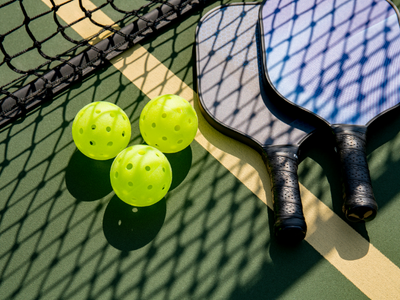
Across the decades, different sports have come to be all the rage amongst particular age groups – perhaps you remember playing four-square and kickball in grade school, participating in the rage of football or basketball season in college, watched as the Spikeball national tournament earned a spot on one of ESPN’s networks.
Sports have a funny way of appealing to different people at different stages of life, and one of which has become very popular with adults aged 55 and older is pickleball. We’ve mentioned pickleball a couple of times in our blogs, talking about the best places to play pickleball and the most common injuries that come from it. With 52% of pickleball players that participate 8 or more times a year falling in that 55+ range and 21% of those who play 8 or less times a year, it’s safe to say that this low-impact sport is a popular way to socialize and get moving, which is extremely important for people of any age.
However, pickleball may not be as low-impact as previously thought – in fact, it may be this perception that’s contributing to the growth in pickleball injuries over the years.
The Impact of Pickleball
While pickleball may seem unassuming at first, no sport that requires regular, fast movement to play should be considered safe. Pickleball combines a lot of the movement of tennis or badminton in a smaller space, leading to quick stops and starts, sharp twists and lunges, and the greater temptation to overstretch the body to reach a ball. This, combined with the use of your shoulder and elbow joints, can lead to any injury you would expect in a ‘high-impact’ sport in comparison.
Perhaps it’s no contact sport or long-distance run, but pickleball will work you up a sweat and leave you sore from working muscles you’re not used to when you start. Your joints, quads, calves, hamstrings, hips, and back will feel the workout – it’s one of the primary reasons pickleball is so popular. Using nearly all the muscle groups in a social sport, what better way to spend your evenings?
Pickleball Injuries on the Court
Unless proper protective and preventative measures are taken, your casual evening game of pickleball might just turn into quite a few evenings of bedrest or, in more serious cases, an evening in the hospital.
Of the approximate 19,000 pickleball injuries every year (based off of a 2019 study) 90% of them affect players 50 and older, who are already at a higher risk of injury due to the natural degeneration of muscles, flexibility, cartilage, and bone density. This fact makes the emergency-room injuries identified in a 2021 study falling into a Slip/Trip/Fall/Dive category quite serious, yet extraordinarily common, since players over 60 accounted for 85% of those emergency room visits and equaled the number of ER visits for tennis of players in the same age group.
The most common pickleball injuries include:
- Slip/trip/fall/dive
- Achilles strains/tears
- Shoulder injuries
- Rotator cuff injuries
- Lower back injuries (especially disc-centric ones such as herniated or bulging discs)
- Fractures
- Epicondylitis (tennis elbow…or pickleball elbow)
Should I Play Pickleball At All?
Yes!
The purpose of this blog isn’t to scare anybody off of playing the phenomenon known as pickleball – it’s just to inform you about the proper way to go about it so that you can keep on playing for years to come.
If the perception of risk isn’t lower, than the correct preventative measures can be taken to avoid any injuries. Stretching – which includes warming up and cooling down – is more important than ever as we age, and going straight into a sport that utilizes muscles as pickleball does invites sprains, strains, and pulled muscles like no other. If there’s a particular part of your body that’s bothering you, then it’s always a good idea to address the pain before it grows.
One way to do this is to participate in healthy aging physical therapy. A common misconception is that physical therapy is only there as a reactionary profession – meaning that it’s only beneficial after an injury. But that’s not true – it helps sustain five key elements that keep us up, running, and on the pickleball court, which are:
- Flexibility
- Strength
- Endurance
- Posture
- Balance
Physical therapy is both a preventative and a reactionary profession – it’s up to you, though, which it may be. Pickleball is a fun, engaging, social sport that is easily enjoyed by all, but it’s risks shouldn’t be taken lightly.
If you’ve been injured, getting back to full strength might take a little longer the older you get, and physical therapy can help get you there. If you or someone you love has suffered a sports injury in the Louisville, Kentucky-area, board certified sports medicine physician Dr. Stacie Grossfeld at Orthopaedic Specialists PLLC can help. Orthopaedic Specialists PLLC is accepting new patients, and same day appointments are available. For additional information or to schedule an appointment, please contact Orthopaedic Specialists PLLC today at 502-212-2663.

Recent Comments